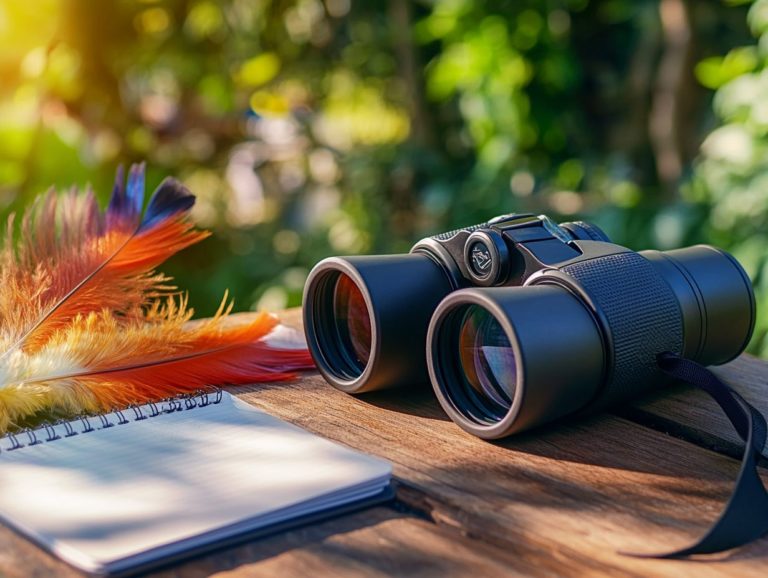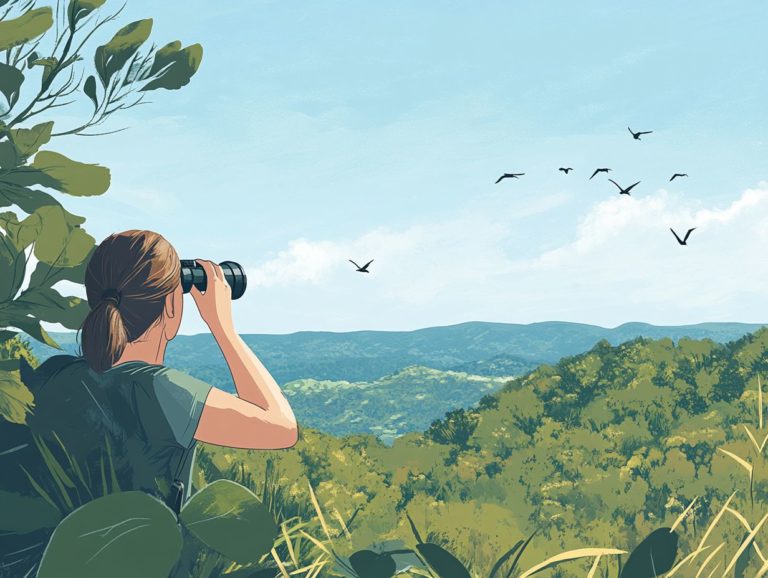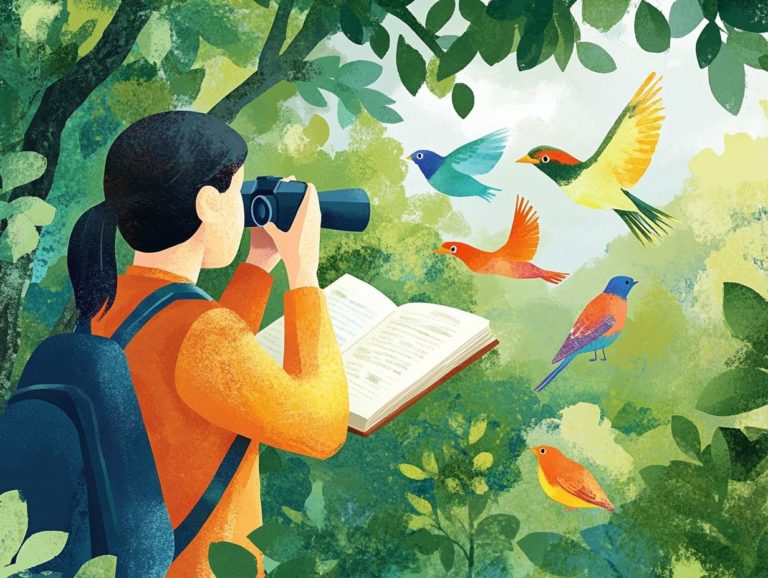5 Signs of an Active Bird Watching Area
Bird watching is a hobby that unveils the wonders of the natural world. Whether you are a novice or an experienced birder, recognizing the signs of a location that is ideal for bird watching can greatly enhance your experience with the right tools and techniques.
Key indicators include a diverse variety of bird species, a thriving local birding community such as those found in urban areas like New York City that provide valuable insights and support, and the availability of services and amenities tailored to birdwatchers.
In this article, we will explore five signs that indicate a location is suitable for bird watching. We will also provide tips to enrich your birding experience and suggest ways to contribute to conservation efforts, which are essential for maintaining healthy ecosystems for birds, like the Osprey and Black-crowned Night Heron found near wetlands and lakes.
The following are the signs that suggest a location is good for bird watching.
Contents
- Key Takeaways:
- 1. Presence of Various Bird Species
- 2. Sightings of Rare or Uncommon Birds
- 3. Evidence of Nesting or Breeding
- 4. Well-Maintained and Established Trails or Viewing Areas
- 5. Active Birding Community
- What Makes an Area Ideal for Bird Watching?
- Frequently Asked Questions
- 1. What are the signs of an active bird watching area?
- 2. How do I know if a bird watching area is active?
- 3. Can bird feeders indicate an active bird watching area?
- 4. Are bird calls and songs important signs of an active bird watching area?
- 5. What role do other bird enthusiasts play in identifying an active area?
- 6. Do different seasons affect the signs of an active bird watching area?
Key Takeaways:
- An active bird watching area is characterized by sightings of various bird species, including rare or uncommon ones.
- Evidence of nesting or breeding activity is another sign of an ideal bird watching location.
- Well-maintained trails or viewing areas and a thriving birding community also indicate an active bird watching area.
1. Presence of Various Bird Species
A diverse range of bird species means a healthy ecosystem, making it a great spot for birdwatching. Here, enthusiasts can observe species such as the American Robin, Yellow Warbler, and Osprey in their natural habitat, which is vital for the survival of many North American birds.
Birding in areas rich in biodiversity not only enhances the experience but also promotes the conservation of these species. Important times when birds migrate allow birders to observe different species as they travel. Early morning is significant for spotting various species and understanding their behaviors.
This abundance allows novice birders of all levels to engage more fully in the hobby, leading to more successful outings and a deeper appreciation of avian biodiversity.
In North America, migratory birds like the Eastern Bluebird and Scarlet Tanager herald the arrival of spring. Parks, wetlands, and forests are popular birding spots where these species gather, providing enthusiasts with opportunities to enjoy their presence.
Different habitats offer unique chances to witness fascinating behaviors and interactions, enriching the learning experience. For beginners looking to improve their identification skills, investing in a good field guide, such as the Sibley Backyard Birding Flashcards, is essential.
Observing traits such as plumage colors, songs, and feeding behaviors can make each birdwatching outing rewarding. The journey of learning about and understanding these creatures is often as fulfilling as spotting them.
2. Sightings of Rare or Uncommon Birds
Sightings of rare or uncommon birds can turn a simple birdwatching trip into an unforgettable adventure! These sightings captivate the interest of dedicated birders eager to enhance their knowledge and appreciation of avian life.
Whether it’s the vibrant feathers of a Harlequin Duck (Histrionicus histrionicus) or the distinctive call of a rarely seen Black-capped Petrel (Pterodroma hasitata), these species underscore the rich biodiversity of their habitats.
While birders are often drawn to the thrill of spotting these rare species, this excitement also carries a significant responsibility. For these rare species to thrive, their habitats must be treated with care. Disturbances in habitats can indicate environmental changes that affect bird populations.
Ethical bird-watching practices, such as maintaining a respectful distance and avoiding loud noises, not only protect the birds themselves but also safeguard the fragile ecosystems they depend on.
3. Evidence of Nesting or Breeding
Observing evidence of nesting or breeding in areas with rich vegetation attracts a variety of bird species. This is crucial for birdwatching, as it indicates the health of an ecosystem and offers birders the chance to witness important life cycles in action.
Recognizing these signs can enhance the birdwatching experience and deepen one’s understanding of avian behavior. Look for specific clues, such as the gathering of materials like twigs and leaves or frequent visits to a particular location, which may suggest active nesting.
Pay attention to birds showing their territory and vocalizations, as these are often precursors to mating and nest establishment. It is essential to engage in ethical birding practices that minimize disturbances to wildlife. Maintaining a respectful distance and avoiding disturbances can help reduce stress on these birds during critical reproductive phases.
By following these guidelines, enthusiasts can enjoy their observations while contributing to the well-being of the species.
4. Well-Maintained and Established Trails or Viewing Areas
Well-established trails and viewing areas enhance the birdwatching experience by offering easy access to habitats where enthusiasts can observe birds in their natural settings. These areas typically feature well-designed trails that meander through a variety of ecosystems, including wetlands, woodlands, and grasslands, each leading to different avian communities.
Observation points are often strategically placed and equipped with benches or hides, allowing birdwatchers to remain inconspicuous while waiting for their target species. Interpretive signage can enrich the outing by providing insights about the surroundings, while field guides equip observers with the skills to identify birds based on their appearance, behavior, or calls.
5. Active Birding Community
A vibrant birding community fosters a supportive environment for both novice and experienced birders, enabling individuals to share knowledge and experiences that enrich the overall birding journey and contribute to conservation efforts.
Being part of such a community offers valuable learning opportunities as members engage in discussions covering topics from tips on identifying various birds to best practices for maintaining clean bird feeders and understanding migratory patterns, which refers to how birds move from one region to another during different seasons.
Participants also have the chance to build meaningful relationships through networking, connecting with one another over shared interests and experiences in the field. Group outings create opportunities for experiential learning in a collaborative setting, transforming birding into a social activity rather than a solitary pursuit.
Resources like eBird allow members to report their sightings and discover new birding locations through the observations of others. Additionally, Birding Pal helps connect birders with local guides or partners, enhancing the joy of discovering beautiful birds together.
What Makes an Area Ideal for Bird Watching?
The perfect bird-watching spot is bursting with diverse natural habitats! An ideal area features a variety of natural habitats that support different bird species, allowing bird watchers to spot migratory birds while practicing ethical birding that contributes to conservation efforts.
Wetlands attract waterfowl, forests are home to songbirds, and open fields draw raptors, creating environments rich in avian diversity. Don’t miss the chance to spot these beautiful species while you can! Accessibility is key; well-maintained trails and observation points encourage both serious and casual bird watchers to explore these areas.
Active local bird watching communities foster collaboration and the sharing of knowledge and skills, enhancing appreciation for nature and its inhabitants. Ethical birding plays a crucial role in protecting bird populations, ensuring that future generations can enjoy the beauty and diversity of the natural world.
Have you ever wondered what makes a location perfect for spotting birds?
What Are Some Common Birds to Look Out For?
When birdwatching, some common species to look out for include the American Robin, Yellow Warbler, and Black-crowned Night Heron. These birds provide unique sightings all year. Their behaviors, feeding habits, and habitats captivate every observer.
The American Robin is frequently spotted foraging in parks and gardens. Its cheerful song signals spring’s arrival. The Yellow Warbler, a vibrant yellow bird, thrives in shrubby habitats near water, making it a common sight near ponds and wetlands.
Meanwhile, the Black-crowned Night Heron, a nocturnal species that often nests in colonies, is particularly interesting to observe at dusk. Their distinctive calls aid in identification, as each species has a unique sound that can be recognized with practice. Noting their feeding habits enhances the birdwatching experience.
How Can One Identify Different Bird Species?
Identifying bird species is crucial for birdwatchers. It enhances the overall birdwatching experience. This can be achieved through the use of binoculars, field guides, and the ability to recognize bird calls, which provide essential clues for identifying birds in their natural habitat.
For those looking to refine this skill, several techniques can be beneficial. Mobile apps can assist in identifying birds by their calls and provide images and detailed descriptions for visual identification.
Careful observation is crucial; noting details such as size, color patterns, and specific behaviors can help differentiate similar species. Keeping a field journal to record sightings and experiences can improve skills over time and foster a greater appreciation for nature and its bird species.
What Are Some Tips for Attracting Birds to an Area?
You can attract birds to your area for better observation. Use ethical practices that protect their habitats and minimize disturbances. Here are some effective methods:
Plant Native Vegetation: Local bird species are drawn to areas with abundant food sources and shelter. By planting native vegetation that is well-suited to the region, you can attract local bird species to your yard. Native plants are essential for maintaining a balanced ecosystem, as their presence encourages birds, insects, and other wildlife to thrive. Thoughtfully planting native bushes, grasses, and trees can significantly enhance the birdwatching experience.
Bird Feeders: Strategically placing bird feeders can also attract birds to a specific location. These feeders provide an important source of extra nutrition, especially during the winter months when food may be scarce. Properly positioning bird feeders can enhance the chances of attracting birds in winter, further enriching your birdwatching experience.
How Can One Contribute to Bird Conservation in an Active Bird Watching Area?
You can help conserve birds in active watching areas. This support is vital for their survival. Contributing to bird conservation in these areas is essential for sustaining bird populations. This can be achieved through local initiatives and programs run by organizations such as the Cornell Lab of Ornithology and eBird.
Citizen science projects enable enthusiasts to gather valuable information about bird populations and their habitats, which can be utilized by researchers in their studies. Reporting sightings helps track migratory routes and may identify areas that require protection or restoration.
Community-based conservation initiatives are often supported by local individuals who offer educational resources, workshops, and volunteering opportunities. By working together, these efforts not only enhance the well-being of bird species but also promote the preservation of biodiversity within their communities.
What Are the Benefits of Bird Watching for the Environment and Community?
Bird watching enriches our environment and strengthens our communities. It deepens our understanding of bird habitats and promotes ethical birding practices.
These practices play a key role in conservation. Enthusiasts help track migratory patterns and observe habitats, raising awareness of environmental issues.
Local economies thrive as bird watchers shop at local stores and stay in lodges. Areas embracing ecotourism reap significant benefits.
A great example is the Great Backyard Bird Count. This initiative engages volunteers in monitoring bird populations and provides valuable data for conservationists.
Such activities boost species protection and strengthen community bonds. Sharing birding experiences fosters teamwork and supports local conservation projects.
Frequently Asked Questions
1. What are the signs of an active bird watching area?
The signs of an active bird watching area include a variety of bird species, frequent sightings, bird calls and songs, feeders, and other enthusiasts.
2. How do I know if a bird watching area is active?
You can identify an active bird watching area by observing the variety of species, how often birds are spotted, and the presence of bird-related activities.
3. Can bird feeders indicate an active bird watching area?
Yes, bird feeders can indicate an active area. Their presence often attracts many birds.
4. Are bird calls and songs important signs of an active bird watching area?
Yes, these sounds help bird watchers identify different species and track their movements.
5. What role do other bird enthusiasts play in identifying an active area?
If you see others actively bird watching, it’s a good sign the area is active. These individuals often know the area well.
6. Do different seasons affect the signs of an active bird watching area?
Yes, signs can vary by season. Different species may be present at different times, influenced by migration patterns and weather.
Join the bird watching community today!



